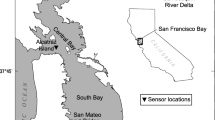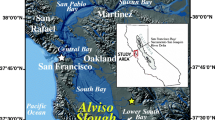Abstract
Suspended sediment fluxes to and from tidal wetlands are of increasing concern because of habitat restoration efforts, wetland sustainability as sea level rises, and potential contaminant accumulation. We measured water and sediment fluxes through two channels on Browns Island, at the landward end of San Francisco Bay, United States, to determine the factors that control sediment fluxes on and off the island. In situ instrumentation was deployed between October 10 and November 13, 2003. Acoustic Doppler current profilers and the index velocity method were employed to calculate water fluxes. Suspended sediment concentrations (SSC) were determined with optical sensors and cross-sectional water sampling. All procedures were analyzed for their contribution to total error in the flux measurement. The inability to close the water balance and determination of constituent concentration were identified as the main sources of error; total error was 27% for net sediment flux. The water budget for the island was computed, with an unaccounted input of 0.20 m3s−1 (22% of mean inflow), after considering channel flow, change in water storage, evapotranspiration, and precipitation. The net imbalance may be a combination of groundwater seepage, overland flow, and flow through minor channels. Change of island water storage, caused by local variations in water surface elevation, dominated the tidally averaged water flux. These variations were mainly caused by wind and barometric pressure change, which alter regional water levels throughout the Sacramento-San Joaquin River Delta. Peak instantaneous ebb flow was 35% greater than peak flood flow, indicating an ebbdominant system, though dominance varied with the spring-neap cycle. SSC were controlled by wind-wave resuspension adjacent to the island and local tidal currents that mobilized sediment from the channel bed. During neap tides sediment was imported onto the island but during spring tides sediment was exported because the main channel became ebb dominant. Over the 34-d monitoring period 14,000 kg of suspended sediment were imported through the two channels. The water imbalance may affect the sediment balance if the unmeasured water transport pathways are capable of transporting large amounts of sediment. We estimate a maximum of 2,800 kg of sediment may have been exported through unmeasured pathways, giving a minimum ent import of 11,200 kg. Sediment flux measurements provide insight on tidal to fortnightly marsh sedimentation processes, especially in complex systems where sedimentation is spatially and temporally variable.
Similar content being viewed by others
Literature Cited
American Society for Testing and Materials (ASTM). 2002. Standard Test Methods for Determining Sediment Concentration in Water Samples. American Society for Testing and Materials International, ASTM D 3977-97, 11.02. West Conshohocken, Pennsylvania.
Bartholdy, J., C. Christiansen, andH. Kunzendorf. 2004. Long term variations in backbarrier salt marsh deposition on the Skallingen peninsula-the Danish Wadden Sea.Marine Geology 203:1–21.
Cahoon, D. R., J. C. Lynch, andA. N. Powell. 1996. Marsh vertical accretion in a southern California estuary, U.S.A.Estuarine Coastal and Shelf Science 43:19–32.
Christiansen, T., P. L. Wiberg, andT. G. Milligan. 2000. Flow and sediment transport on a tidal salt marsh surface.Estuarine Coastal and Shelf Science 50:315–331.
Edwards, T. K. andG. D. Glysson. 1999. Field methods for measurement of fluvial sediment, p. 1–89. In Techniques of Water-Resources Investigations, Book 3. U.S. Geological Survey, Reston, Virginia.
Fischer, H. B., E. G. List, R. C. Y. Koh, J. Imberger, andN. H. Brooks. 1979. Mixing in Inland and Coastal Waters, 1st edition. Academic Press, San Diego, California.
Friedrichs, C. T. andJ. E. Perry. 2001. Tidal salt marsh morphodynamics: A synthesis.Journal of Coastal Research 27:7–37.
Ganju, N. K. andD. H. Schoellhamer. 2003. Tidal and vertical variability of floc characteristics, p. 6.In J. P.-Y. Maa, D. H. Schoellhamer, and L. P. Sanford (eds.), Proceedings of the 7th International Conference on Nearshore and Estuarine Cohesive Sediment Transport Processes. Virginia Institute of Marine Science Gloucester Point, Virginia.
Gartner, J. W. and R. T. Cheng. 2001. The promises and pitfalls of estimating total suspended solids based on backscatter intensity from acoustic Doppler current profilers, p. 119–126.In G. D. Glysson (ed.), Proceedings of the 7th Federal Interagency Sedimentation Conference, U.S. Subcommittee on Sedimentation, Reno, Nevada.
Goodbred, S. L. andA. C. Hine. 1995. Coastal storm deposition: Salt-marsh response to a severe extratropical storm, March 1993, west-central Florida.Geology 23:679–682.
Hemond, H. F. andJ. L. Fifield. 1982. Subsurface flow in salt marsh peat: A model and field study.Limnology and Oceanography 27:126–136.
Hemond, H. F., W. K. Nuttle, R. W. Burke, andK. D. Stolzenbach. 1984. Surface infiltration in salt marshes: Theory, measurement, and biogeochemcial implications.Water Resources Research 20:591–600.
Krone, R. B. 1979. Sedimentation in the San Francisco Bay system, p. 85–96.In T. J. Conomos (ed.), San Francisco Bay: The Urbanized Estuary. Pacific Division of the American Association for the Advancement of Science. San Francisco, California.
Leonard, L. A. 1997. Controls of sediment transport and deposition in an incised mainland marsh basin, southeatern North Carolina.Wetlands 17:263–274.
Marvin-DiPasquale, M. andJ. L. Agee. 2003. Microbial mercury cycling in sediments of the San Francisco Bay-Delta.Estuaries 26:1517–1528.
Nuttle, W. K. 1988. The extent of lateral water movement in the sediments of a New England salt marsh.Water Resources Research 24:2077–2085.
Nyman, J. A., C. R. Crozier, andR. D. Delaune. 1995. Roles and patterns of hurricane sedimentation in an estuarine marsh landscape.Estuarine Coastal and Sehlf Science 40:665–679.
Pillay, S., L. R. Gardner, andB. Kjerfve. 1992. The effect of crosss-sectional velocity and concentration variations on suspended sediment transport rates in tidal creeks.Estuarine, Coastal and Shelf Science 35:331–345.
Pont, D., J. W. Day, P. Hensel, E. Franquet, F. Torre, P. Rioual, C. Ibanez, andE. Coulet. 2002. Response scenarios for the deltaic plain of the Rhone in the face of an acceleration in the rate of sea-level rise with special attention toSalicornia-type environments.Estuaries 25:337–358.
Reed, D. J. 2002. Understanding tidal marsh sedimentation in the Sacramento-San Joaquin Delta, California.Journal of Coastal Research 36:605–611.
Ruhl, C. A. and D. H. Schoellhamer. 2004. Spatial and temporal variability of suspended-sediment concentrations in a shallow estuarine environment.San Francisco Estuary and Watershed Science 2: Article 1. http://repositories.cdlib.org/jmie/sfews/vol2/iss2/art1
Simpson, M. R. and R. Bland. Methods for accurate estimation of net discharge in a tidal channel.Institute of Electrical and Electronics Engineers Journal of Oceanic Engineering 25:437–445.
Sontek. 2001. Principles of Operation, Argonaut-Series Instruments. Technical Documentation, Sontek, San Diego, California.
Suk, N. S., Q. Guo, andN. P. Psuty. 1999. Suspended solids flux between salt marsh and adjacent bay: A long-term continuous measurement.Estuarine Coastal and Shelf Science 49:61–81.
Temmerman, S., G. Govers, S. Wartel, andP. Meire. 2004. Modelling estuarine variations in tidal marsh sedimentation: Response to changing sea level, and suspended sediment concentrations.Marine Geology 212:1–19.
Tobin, A., D. H. Schoellhamer, and J. R. Burau. 1995. Suspended-solids flux in Suisun Bay, California, p. 1511–1515.In W. H. Espey, Jr. and P. G. Combs (eds.), Proceedings of the First International Conference on Water Resources Engineering, American Society of Civil Engineers, New York.
Walters, R. A. andJ. W. Gartner. 1985. Sub-tidal sea level and current variations in the northern reach of San Francisco Bay.Estuarine Coastal and Shelf Science 21:17–32.
Wright, S. A. and D. H. Schoellhamer. 2004. Trends in the sediment yield of the Sacramento River, California, 1957–2001.San Francisco Estuary and Watershed Science 2∶2, http://repositories.cdlib.org/jmie/sfews/vol2/iss2/art2.
Yang, S. L. 1998. The role ofScirpus marsh in attenuation of hydrodynamics and retention of fine sediment in the Yangtze Estuary.Estuarine Coastal and Shelf Science 47:227–233.
Sources of Unpublished Materials
California Department of Water Resources. 2002. unpublished data. California Data Exchange Center. http://cdec.water.ca.gov.
Hippe, R. personal communication. RD Instruments, 9855 Businesspark Avenue, San Diego, California 92131.
RD Instruments. 2003. Workhorse Monitor ADCP specification sheet. http://www.rdinstruments.com/pdfs/Mon213.pdf.
Author information
Authors and Affiliations
Corresponding author
Rights and permissions
About this article
Cite this article
Ganju, N.K., Schoellhamer, D.H. & Bergamaschi, B.A. Suspended sediment fluxes in a tidal wetland: Measurement, controlling factors, and error analysis. Estuaries 28, 812–822 (2005). https://doi.org/10.1007/BF02696011
Received:
Revised:
Accepted:
Issue Date:
DOI: https://doi.org/10.1007/BF02696011




